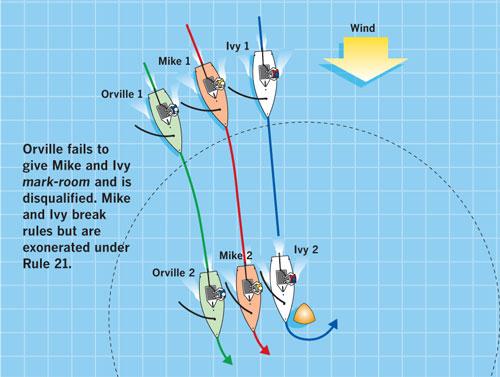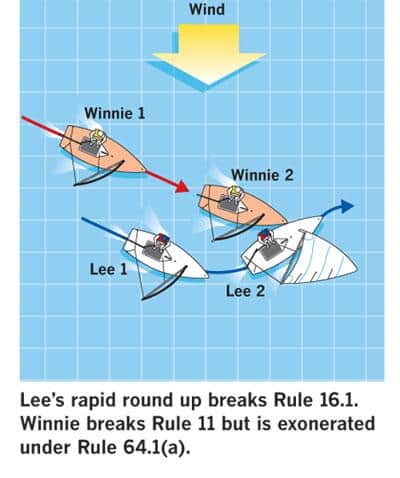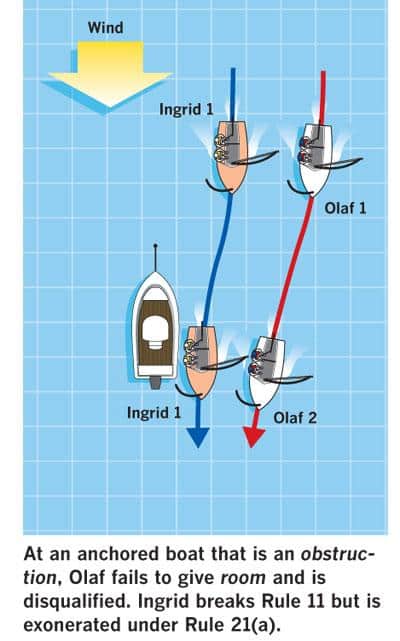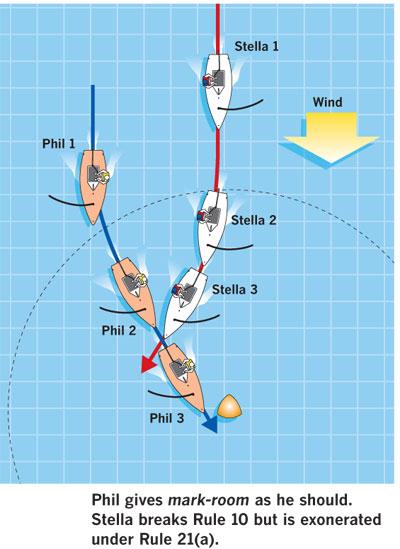This month we continue to explore significant changes in the racing rules, focusing on the change in the definition Room, and on changes in the rules that make use of the concept of exoneration. Some words have been added to the definition Room, which is shown below with the new words in bold.

The additional words are helpful in situations involving more than two boats. The scenario shown in the first diagram provides an example. When they enter the zone around the leeward mark at Position 1, Orville, Mike, and Ivy are overlapped on port tack. The mark is to be left to port, and the next leg is a beat to windward. Orville is required to give mark–room to both Mike and Ivy, and Mike is required to give mark–room to Ivy. The new words in the definition make it clear that Orville must give Mike enough space to enable Mike to give mark–room to Ivy. There’s more to come about Orville, Mike, and Ivy.
| Definition: Room The space a boat needs in the existing conditions, including space to comply with her obligations under the rules of Part 2 and rules 31, while maneuvering promptly in a seamanlike way. |
These added words also impact the analysis of a simple luffing situation. Suppose three boats on the same tack are overlapped and Rule 17 does not restrict the leeward boat’s right to luff. If the leeward boat luffs, she is required by Rule 16.1 to give the middle boat room to keep clear. The space the leeward boat must give the middle boat includes space for the middle boat to fulfill her obligation under Rule 16.1 to give the windward boat room to keep clear.
The concept of exoneration is used more often in the 2013 rulebook than it has ever been used before. So just what is “exoneration?” There are three rules, Rules 64.1(a), 14(b), and 21, that state conditions under which a boat that breaks a rule will be exonerated for breaking that rule. If a boat is exonerated for breaking a particular rule, the protest committee can’t disqualify her for breaking that rule. Here’s a summary of those three rules:
• When Boat B breaks a rule, and as a consequence, B compels Boat A to break a rule, A is exonerated under Rule 64.1(a).
• When Boat A is entitled to room or mark–room from Boat B under Rule 18, 19 or 20 and A is “sailing within” that room or mark-room, A is exonerated under Rule 21 if, in an incident with B, A breaks Rule 10, 11, 12, 13, 15, or 16, or if A is compelled to touch a mark.
• When Boat A breaks Rule 14 by making contact with Boat B, if A had right of way or was entitled to room or mark-room at the time of the contact, A is exonerated under Rule 14(b) if the contact does not cause damage or injury.
The diagrams show situations in which exoneration occurs. In the first diagram, at Position 1, Orville becomes obligated to give Mike and Ivy room to sail to the mark and leave it on the required side (see definition Mark–Room). Orville gives so little space to Mike that at Position 2 Mike cannot avoid making contact with both Orville and Ivy, and Ivy touches the mark. Orville breaks Rules 18.2(b) and 14, and is disqualified because no rule exonerates him. Mike breaks Rule 11 by failing to keep clear of Orville and Rule 18.2(b) by failing to give Ivy mark-room; Ivy breaks Rule 11 by failing to keep clear of Mike and Rule 31 by touching the mark. Rule 21 exonerates Mike for breaking Rule 11 and Ivy for breaking Rules 11 and 31. Orville’s breach of Rule 18.2(b) compelled Mike to break Rule 18.2(b), and therefore, Mike is exonerated under Rule 64.1(a) for breaking Rule 18.2(b). Note that Mike and Ivy do not break Rule 14 because it was not reasonably possible for them to have avoided the contact after it became clear that Orville wasn’t going to give them mark-room (see Rule 14(a)).

In the second diagram, Winnie and Lee are reaching on port tack. Lee, the leeward boat, loses control in a sharp gust of wind and rounds up rapidly into Winnie’s path. The boats collide. Lee breaks Rule 16.1 because there was no seamanlike way for Winnie to keep clear of Lee in the short time between when Lee began to round up and when the boats collided. Winnie broke Rule 11, but is exonerated by Rule 64.1(a) because she was compelled to break that rule by Lee’s breach of Rule 16.1. Winnie did not break Rule 14 because it wasn’t reasonably possible for her to avoid the contact after it became clear Lee was not giving her room to keep clear.

In the third diagram, Ingrid and Olaf have been overlapped as they approach an anchored boat that is an obstruction. Olaf chooses to leave the obstruction to starboard, but he does not give Ingrid room to pass between him and the obstruction, as he is required to do by Rule 19.2(b). Olaf breaks Rule 19.2(b) and isn’t exonerated. Ingrid was sailing within the room to which she was entitled. Faced with a choice of hitting the anchored boat or hitting Olaf, Ingrid chooses to hit Olaf and, therefore, breaks Rule 11. Rule 21 exonerates her for breaking Rule 11.
If Ingrid and Olaf had been on the last leg of the course, and the anchored boat was one of the finishing line marks, Rule 18 would have applied instead of Rule 19. In this case, Ingrid would be entitled to mark-room under Rule 18.2(b), and Olaf would break that rule by failing to give Ingrid room to leave the mark to starboard. Olaf would not be exonerated, but Rule 21 would exonerate Ingrid for breaking Rule 11.

In the fourth diagram, Phil—on port tack—and Stella—on starboard tack—are running toward a leeward mark to be left to port. The next leg is a beat to windward. When Phil reaches the zone at Position 1, he is clear ahead of Stella. Therefore, Rule 18.2(b) applies and entitles Phil to mark-room. Between Positions 1 and 3 Phil is entitled to space to sail in a seamanlike manner to the mark—i.e., to a position in which his bow is close to and on the required side of the mark (see ISAF Case 118). Between Positions 1 and 3 Phil sails within the mark-room to which he is entitled. Stella surfs on a wave, and just before she would have run into Phil’s stern, she luffs to avoid contact. Stella protests Phil for breaking Rule 10. The protest committee finds that Stella gave Phil_ mark-room_ as required by Rule 18.2(b), and that she also avoided contact with him as required by Rule 14. Just before Stella reached Position 3, she needed to take action to avoid Phil, and so Phil broke Rule 10. However, because Phil was sailing within the mark-room to which he was entitled, he is exonerated under Rule 21(a). Neither boat is disqualified.









